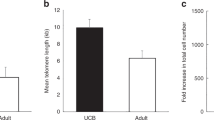Abstract
Stem cells have the ability to divide for indefinite periods in culture and to give rise to specialized cells. Cord blood as a source of hematopoietic stem cells (HSC) has several advantages as it is easily available, involves non-invasive collection procedure and is better tolerated across the HLA barrier. Since the first cord blood transplant in 1988, over 2500 cord blood HSC transplants have been done world wide. Since then, the advantages of cord blood as a source of hematopietic stem cells for transplantation have become clear. Firstly, the proliferative capacity of HSC in cord blood is superior to that of cells in bone marrow or blood from adults. A 100 ml unit of cord blood contains 1/10th the number of nucleated cells and progenitor cells (CD34+ cells) present in 1000 ml of bone marrow, but because they proliferate rapidly, the stem cell in a single unit of cord blood can reconstitute the entire haematopoietic system. Secondly, the use of cord blood reduces the risk of graft vs host disease. Cord Blood Stem Cell banks have been established in Europe and United States to supply HSC for related and unrelated donors. Currently, more than 65000 units are available and more than 2500 patients have received transplants of cord blood. Results in children have clearly shown that the number of nucleated cells in the infused cord blood influences the speed of recovery of neutrophils and platelets after myeloablative chemotherapy. The optimal dose is about 2 x 107 nucleated cells/kg of body weight. The present study was carried out for collection, separation, enumeration and cryopreservation of cord blood HSC and establishing a Cord Blood HSC Bank. 172 samples of cord blood HSC were collected after delivery of infant prior to expulsion of placenta. The average cord blood volume collected was 101.20 ml. Mononuclear cell count ranged from 7.36 to 25.6 x 107/ml. Viability count of mononuclear cells was 98.1%. After 1 year of cryopreservation, the viability count on revival was over 82.1 %. Related cord blood stem cell transplantation was carried out in three cases at Army Hospital (R & R), Delhi Cantt.
Similar content being viewed by others
References
Gluckman E. Haematopoietic Stem Cell Transplants Using Umbilical Cord Blood.N Engl J Med 2001; 344(24): 1860–1861.
Armitage J. Bone Marrow Transpianation.N Engl J Med 1994; 330:827–832.
Harris DT, Schumacher MJ, Rychlik S, Booth A. Collection, separation and cryopreservation of umbilical cord blood for use in transplantation.Bone Marrow Transplantation 1994; 13: 135–143.
Rubinstein P, Dobrila L, Rosenfield RE. Processing and cryopreservation of placental/umbilical cord blood for unrelated bone marrow reconstitution.Proc Natl Acad Sci USA 1995; 92:10119–10122.
Technology Transfer protocol for collection and cryopreservation of haematopoietic stem cells. CRI, Mumbai and NCCS Pune, 1998.
Voak D, Cann R, Finney RD. Guidelines for collection, processing and storage of human bone marrow and peripheral stem cells for transplantation.Transfusion Medicine 1994; 4: 168–172.
Rubinstein P. Unrelated placental blood for bone marrow reconstitution, organisation of placental blood programme.Blood Cells 1994; 20; 587–600.
Clay ME, Faitsch S, Noreen H, Segall M. Proposed policies and procedure for the establishment of cord blood bank.Blood Cells 1994; 20 (2–3): 609–626.
Confer DL Unrelated marrow donor registeries.Curr Opin Hematol 1997; 4:408–413.
Wagner JE, Kurtzberg J. Allogeneic umbilical cord blood transplantation. In Broxmeyer HE ed.Cellular Characteristics of Cord Blood and Cord Blood Transplantation. AABB Press, Bethesda,MD, 1998,p113
Cairo MS, Wagner JE. Placental and/or Umbilical Cord Blood: An Alternative Source of Hematopoietic Stem Cells for Transplantation.Blood 1997; 90(12): 4665–4675.
Author information
Authors and Affiliations
Corresponding author
Rights and permissions
About this article
Cite this article
Dhot, P.S., Nair, V., Swarup, D. et al. Cord blood stem cell banking and transplantation. Indian J Pediatr 70, 989–992 (2003). https://doi.org/10.1007/BF02723826
Issue Date:
DOI: https://doi.org/10.1007/BF02723826




